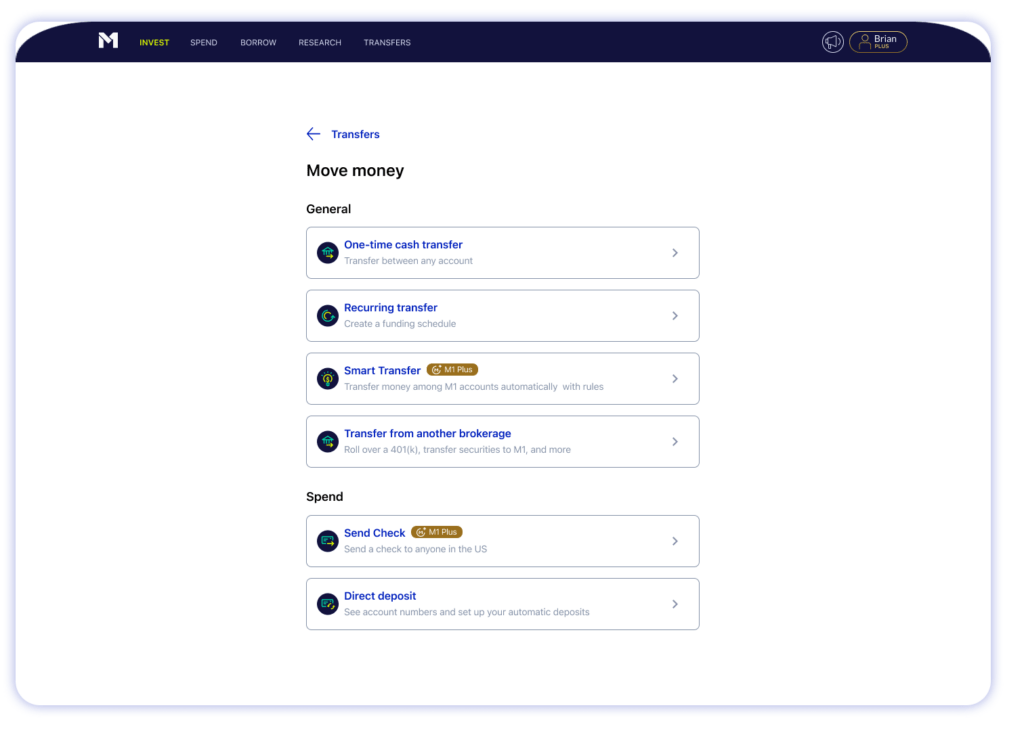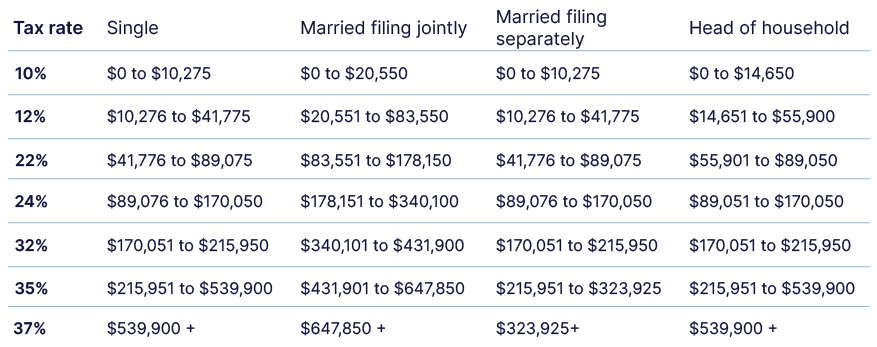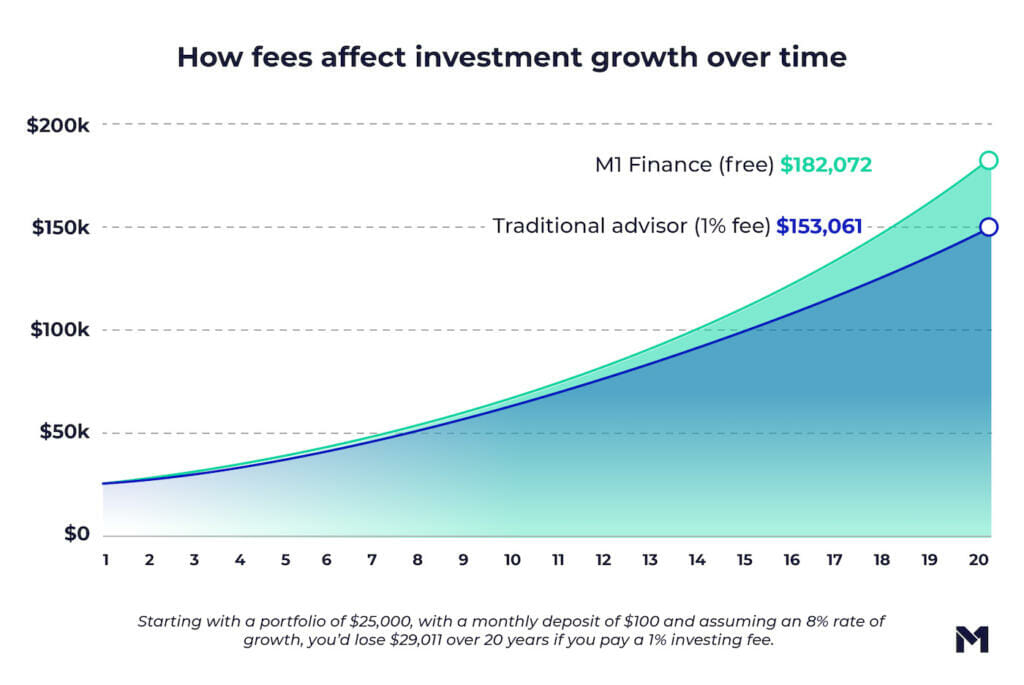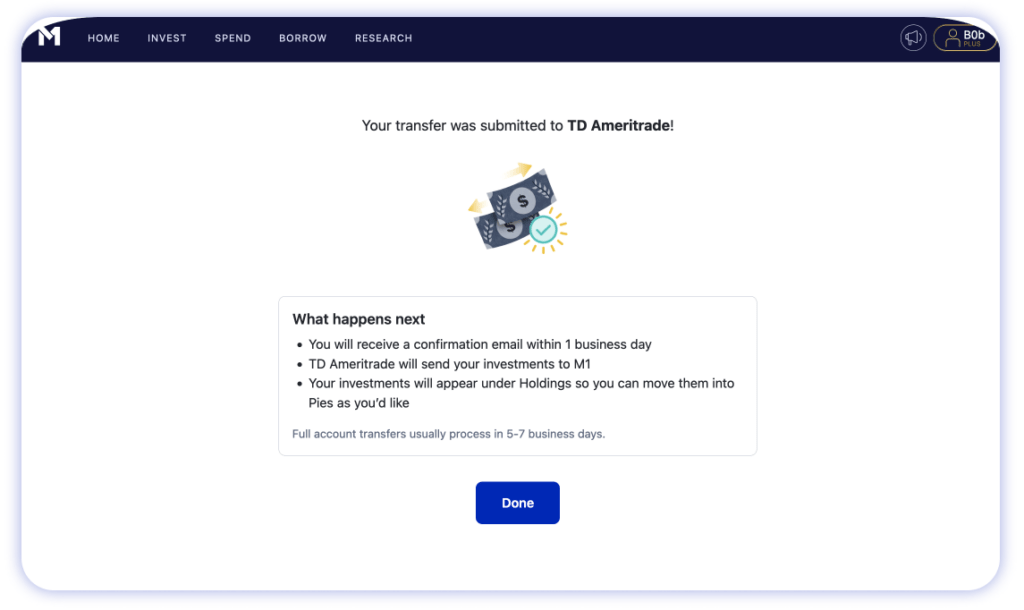9 myths about brokerage account transfers

The right brokerage is a key factor to making the most of your investments.
We’re past the days of brokerages that only let you trade stocks. Now, different brokerages offer a variety of features that can help you build your wealth. The trick is to choose the one that best aligns with your investment strategy and financial goals.
With more investors recognizing long-term investing as a smart, sustainable way to build wealth, one of the most common questions clients ask is “Can I transfer an existing account to M1?” The answer is yes, you absolutely can. But as with most things in investing, the details matter.
There’s a lot of misinformation about brokerage accounts, so we condensed thousands of client questions into nine common myths about the account transfer process.

Myth 1: Brokerage transfers require you to pay taxes.
Not necessarily. If you do an in-kind transfer, meaning you move your stocks from one brokerage to another without buying or selling, you won’t pay taxes because the transfer isn’t considered a taxable event.
But if you liquidate the assets you hold at your current brokerage and transfer the money as cash, you may have to pay capital gains taxes on the sale of any securities in a taxable account (like an individual or joint trust account).
The amount you owe will depend on your tax rate, the type of securities you have, and whether they’re short-term or long-term capital gains.
2022 short-term capital gains taxes

2022 long-term capital gains taxes

If your securities are held in a non-taxable brokerage account (like a retirement account), you won’t incur capital gains taxes when you liquidate and transfer to a new brokerage. This includes many types of IRAs like traditional, Roth, or SEP.
You don’t have to liquidate your retirement account to transfer to another brokerage. You can transfer your IRA account in the same way you transfer a taxable account.
A note: 401(k) transfers are different. If you’re thinking about transferring over a 401(k), consider rolling your 401(k) into an IRA. The right choice for you depends on which type of account you currently have and you are encouraged to consult your personal investment, legal, or tax advisors.
Myth 2: Brokerage account transfers have hefty fees.
The fees you pay to your current brokerage to close or transfer your account are often a misconception—here are three reasons why:
1. Over time, a commission-free platform can potentially help compensate for transfer fees.
The fees to transfer brokerage accounts typically range from $50 to $200. Let’s say your current brokerage charges fees for account management or purchasing new securities. If you transfer to a new brokerage firm that charges lower (or no) fees, you could potentially make up the difference. Of course, this depends on many different factors including how much money you have in your account and how often you update your portfolio.
Here’s how a 1% fee impacts a $25,000 portfolio over time.

2. The fee could be lower than taxes you’d pay.
You could potentially avoid the fee by liquidating your account and transferring the cash to a new brokerage.
In most cases, this would be considered a taxable event, meaning you’d have to pay taxes on your gains (the tax rate would vary based on the type of investments you have and how long you’ve held them).
If the taxes are greater than the fee, the fee might be a good deal. But if you’re transferring an IRA, you don’t have to pay capital gains taxes on the pre-transfer sale of your securities.
3. In-kind transfers can give you peace of mind.
Even if the fee is larger than the amount you’d pay in taxes, you may still want to pay it simply for the convenience of having someone else handle the process for you.
In other words, you can think of it as a peace-of-mind fee to make sure your money gets where you want it to be without having to worry about it. And, if you’re considering a transfer you’ve already decided that your new brokerage is better aligned with your investing strategy.
Myth 3: You’ll lose your transaction history.
This one may have been true in the past, but it’s not anymore.
A law passed in 2011 requires brokerages to send your transaction history to your new broker when you transfer. Still, it’s smart to get a copy of your cost basis (the original value of your investment) from your existing brokerage for your records.
Your cost basis will be retained when you transfer to your new brokerage account. This becomes important if and when you pay taxes on the gains of any sales you make in your portfolio; the same holds true for any losses you are potentially trying to harvest.
Myth 4: The brokerage account transfer process is too risky.
All investing activity comes with risk, but account transfers aren’t disproportionately riskier.
Some people get nervous because you can’t make any changes to your portfolio while it’s in transit, usually about seven to 10 business days.
During that short period of time, you’ll be unable to make any trades on the positions you are transferring. But if you’re primarily investing for the long term — say, for retirement or to save up for the down payment on a home — you probably wouldn’t have been making many trades anyway.
After all, the whole point of long-term investing is to devise an investing plan that works on a longer time frame. Short-term fluctuations will happen whether you transfer or not, but they shouldn’t affect your strategy.
Myth 5: You can’t transfer mutual funds.
It depends on your new brokerage. You can transfer mutual funds as long as your new brokerage has an agreement in place to accept the funds or fund families you have money in. But if your new brokerage doesn’t offer the same mutual funds, it doesn’t have to be a deal-breaker. There are other ways to get your money transferred.
For example, you could liquidate your mutual funds at your existing brokerage and purchase similarly structured ETFs at your new brokerage. Many new M1 clients choose to do this, since we don’t offer mutual funds.
Some clients also choose to transfer mutual funds, OTC securities, options, and bonds. If you’re interested in transferring, here’s how we’ll handle it:
- Mutual funds: Liquidate them and give you the cash, which you can reinvest as you see fit.
- OTC securities: We offer some OTC securities through American Depository Receipts (ADRs). If we do not offer your specific OTC security, you can liquidate and reinvest.
- Options: Let them expire. You can’t trade the option while it’s on our platform. If the option is ITM, we will automatically exercise it. You can also conduct a partial transfer excluding your options.
- Bonds: Let them mature. You can’t trade these on M1 right now.
If you have a question about your specific situation, get in touch with us at transfers@m1finance.com.
Myth 6: If you want to transfer, it’s all or nothing.
If you have an account with a major brokerage firm like Charles Schwab, Fidelity, or TD Ameritrade, it’s possible to move part of your account to another platform (including M1). Before doing so, be sure to have ready the securities and number of shares you would like to move.
Some firms, including Betterment and Wealthfront, only allow full transfers. When considering the transfer process between brokerage accounts, make sure to check the brokerage’s policies.
Myth 7: You’ll lose your dividends.
This is entirely false. When switching to a new broker, your principal balance will be transferred on your official transfer date. At M1, this is about seven to 10 business days after you initiate the transfer. If any dividends are sent to your old brokerage after that transfer date, your new brokerage will sweep them into your new account.
Myth 8: Transfers count toward your retirement contribution limit.
Transferring accounts between brokerages doesn’t count toward your retirement limit. When you transfer a brokerage account, you’re not adding money—you’re simply moving it. The same is true of 401(k) to IRA rollovers and qualified reservist repayments: you can make either of these transactions without affecting your contribution limit.
Keep in mind, the IRS limits how much money taxpayers can contribute to IRAs (traditional and Roth) each year. In 2022, that limit is $6,000 (and $7,000 if you’re 50 or older).
Myth 9: Transferring brokerage accounts isn’t worth the hassle.
The process of transferring securities from one brokerage to another can be complex, but your part is straightforward. If you see a clear opportunity for your investments to potentially perform better—say, at a commission free brokerage— simply take these steps for an automated customer account transfer (also called an ACAT transfer).
- Decide which brokerage you want to use for your investing strategy.
- Choose whether to transfer your investments (an in-kind transfer) or liquidate your investments and make a cash transfer.
- Get an account statement from your current brokerage.
- Open an account at your new brokerage that matches the account type you’re transferring (e.g., if you have an IRA, you must open an IRA).
- Start the transfer request by notifying your new brokerage and sending your transfer initiation form statement.

That’s it. Your new brokerage will handle the rest.
This is likely no more than what you’re already doing as an engaged investor: researching your options and considering the costs and benefits of making one choice versus another.
Plus, the brokerage you’re transferring to is motivated to help you move your funds quickly. The more customers it has, the more opportunities it has to earn revenue from those customers. If you’re curious how M1 makes money as a free investing platform, learn more about the M1 revenue model.
The reality is that moving to a new brokerage is no more or less complicated than the other transactions you’d make to manage your finances. If a new brokerage offers features you want and can’t access through your current brokerage, there’s no reason you shouldn’t consider a brokerage account transfer.
Originally published October 21, 2020, updated June 1, 2022.
- Categories
- Invest



